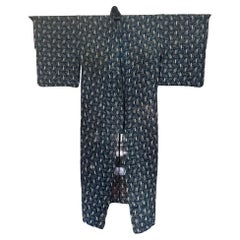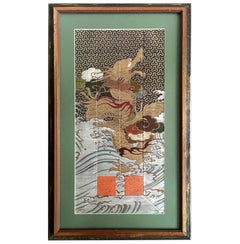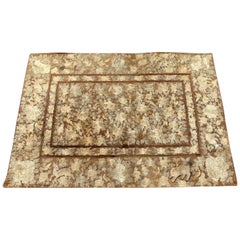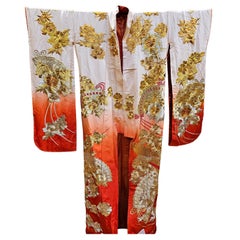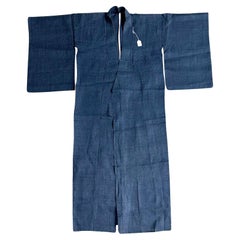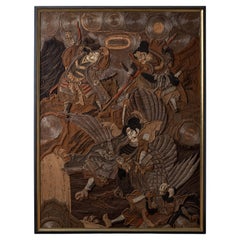Japanese Textiles
to
11
122
14
153
25
1
23
1
1
3
55
95
26
53
25
2
5
1
4
1
2
1
173
94
39
33
32
13,937
1,328
462
443
432
179
176
179
3
Place of Origin: Japanese
Japanese Woven Ikat and Stenciled Summer Usumono Kimono Meiji Period
Located in Atlanta, GA
On offer is a “Natsu No Kimono” (summer kimono) also called “Usumono" (thin clothes) dated from late Meiji Period circa late 19th to early 20th century. This well-preserved garment w...
Category
Early 20th Century Meiji Japanese Textiles
Materials
Linen
Framed Japanese Woven Textile Panel with Dragon Meiji Period
Located in Atlanta, GA
A framed Japanese woven textile circa late 19th century of Meiji Period. Likely a fragment of a priest robe or kesa, the multi-paneled textile was finely woven with gold foiled threads that depicts a five-clawed dragon slithering in the clouds and water...
Category
19th Century Meiji Antique Japanese Textiles
Materials
Silk, Wood
Antique Japanese Embroidery Tapestry Panel Edo Period
Located in Atlanta, GA
A large Japanese silk embroidery tapestry circa 18th century Edo period. Possibly an altar tablecloth originally, the embroidered textile pane...
Category
18th Century Edo Antique Japanese Textiles
Materials
Silk
$3,200 Sale Price
20% Off
Vintage Japanese Silk Brocade Embroidery Ceremonial Kimono in Ivory, Red, Gold
Located in Barrington, IL
An exquisite and visually commanding vintage Uchikake wedding kimono from Japan, dating from the late Meiji to early Taisho period (circa 1910s–1930s). Traditionally worn by brides ...
Category
Early 20th Century Japanese Textiles
Materials
Gold
Japanese Woven Asa Double Ikat Summer Usumono Kimono Provenance
Located in Atlanta, GA
A “Natsu No Kimono” (summer kimono) also called “Usumono" (thin clothes) dated from early 20th century Taisho Period. This well-preserved garment was tailored from a woven indigo blu...
Category
Early 20th Century Taisho Japanese Textiles
Materials
Hemp
Japanese Samurai Battling Tengu Embroidered Tapestry, 19th Century
Located in Savannah, GA
A Meiji tapestry of silk, wool and gold thread depicting samurai battling tengu, 19th century.
56 ¼ inches wide by 74 ½ inches tall by 2 inches deep
Category
19th Century Meiji Antique Japanese Textiles
Materials
Wool, Silk, Wood
Two Post War Kabuki Paddles (Hagoita) Original Shuttlecock Ball Japan Circa 1960
Located in Incline Village, NV
Offered are a pair of post war Japanese Kabuki paddles circa 1960, featuring a male and female Kabuki character actors in full traditional Japanese r...
Category
1960s Mid-Century Modern Vintage Japanese Textiles
Materials
Fabric, Wood
Japanese Antique Fusuka Textile Art Meiji Period
Located in Atlanta, GA
A Japanese silk Fukusa panel circa late 19th-early 20th century of Meiji Period. The front was beautifully decorated with Yuzen-zome, a labor intensive resist-dye technique invested by an artist monk Miyazaki Yuzensai (1654 -1736) of Edo period. The auspicious composition features a group of red-crown cranes, the symbol of longevity. Three of them perch on the rock by the ocean (East Sea) an two of them are in flight. Additionally, two egrets frolic in the wave. Yuzen dying was used extensively to showcase the amazing details such as the waves and the gradual coloring effect. Embroidery was used sparsely to highlight areas such as the legs of the crane to render it more dimensional details.
The piece has a red silk backing and still retains four blue tassels on corners as well as decorative stitches along the edges.
Fukusa is a traditional Japanese textile...
Category
Early 20th Century Japonisme Japanese Textiles
Materials
Brocade, Silk
Japanese Antique Fukusa Textile Art Meiji Period
Located in Atlanta, GA
A Japanese silk Fukusa panel circa late 19th-early 20th century of Meiji Period. The front was beautifully decorated with Yuzen-zome, a labor intensive resist-dye technique invested by an artist monk Miyazaki Yuzensai (1654 -1736) of Edo period. The front cover likely depicts a scene from the Tale of Genji, showing a nobleman and his servant pays a visit to a lady in a fenced thatch-roof house under a high peak. The details of blossom trees and pines, as well as the characters, and scenery with a gradual color are astounding. It is telling that the Yuzen dying was used such an mastery.
The piece has a red silk backing and still retains two red tassels on the lower corners as well as decorative stitches along the edges. There is a patched design on the back likely a Mon symbol (family crest).
Fukusa is a traditional Japanese textile...
Category
Early 20th Century Japonisme Japanese Textiles
Materials
Silk
Framed Japanese Antique Phoenix Dragon Embroidery Tapestry Meiji Period
Located in Atlanta, GA
A visually stunning Japanese embroidery tapestry circa 1890s-1900s late Meiji period, presented with a linen matt with gold trim in a gilt wood frame. The design showcases a flying p...
Category
1890s Japonisme Antique Japanese Textiles
Materials
Silk, Giltwood
Japanese Art Deco Ikat Silk Meisen Kimono
Located in Atlanta, GA
A well preserved Japanese Meisen kimono hand-sewn from woven Ikat Silk circa 1920-30s (Taisho to early Showa period). The kosode style kimono (small slee...
Category
Early 20th Century Showa Japanese Textiles
Materials
Silk
Meiji Period Japanese Indigo Double Ikat Futon Cover
Located in Point Richmond, CA
Meiji period Japanese Indigo double ikat futon cover
Japanese futon cover, a double ikat pattern in four panels depicting Kumamoto Castle with im...
Category
1890s Meiji Antique Japanese Textiles
Materials
Cotton
Japanese Vintage Linen Noren, Textile, Wabi Sabi, 19th Century
Located in Tokyo, Tokyo
The unique and beautiful fabric piece, that's called noren - traditional Japanese fabric divider that was made during the Meiji era. This traditional Japanese curtains used to divide...
Category
19th Century Antique Japanese Textiles
Materials
Linen
Japanese Signed Stamped Hand Drawn Silk Obi Sash Belt with Crow, Mid-1900
Located in Studio City, CA
A wonderful handmade vintage silk Obi sash/ belt featuring a rather unique hand-drawn scene with a crow and trees.
Signed and stamped by the artist...
Category
Mid-20th Century Showa Japanese Textiles
Materials
Silk
Late Meiji Period Sleeping Kimono / Yogi, Japan
Located in Point Richmond, CA
Late Meiji Period sleeping Kimono / Yogi, Japan
Yogi are a type of oversized sleeping kimono traditionally used in Japan. This kimono would have b...
Category
Early 20th Century Tribal Japanese Textiles
Materials
Cotton
Antique Japanese Brocade Monk's Robe Kesa Meiji Period
Located in Atlanta, GA
A Japanese Kesa (Monk's Vestment) made from thirteen columns of patchworks of shimmering woven brocades. The elaborate motifs feature repetitive elaborat...
Category
Late 19th Century Meiji Antique Japanese Textiles
Materials
Brocade, Silk
Framed Japanese Embroidery Textile Panel Meiji Period
Located in Atlanta, GA
A Japanese textile panel with embroidery needlework circa late Meiji period (1900s) presented in a gilt wood frame with silk mat. The work depic...
Category
Early 1900s Meiji Antique Japanese Textiles
Materials
Silk, Wood
An old couple (in Venice) by Blue Tip Atelier
Located in Sammu-shi, Chiba
Title : An old couple (in Venice)
Japan / 2024s
Size : w1960 x h2000 mm
While traveling in Venice, I came across an elderly couple sitting on a bench and was so inspired by their...
Category
2010s Modern Japanese Textiles
Materials
Linen
Antique Japanese Textile Art Campaign Jacket Jinbaori with Mon
Located in Atlanta, GA
Known as Jinabori during 16th century when warfare was common in feudal Japan, the sleeveless jacket was created to be worn outside of the armor by samurai warriors. In addition to s...
Category
19th Century Japonisme Antique Japanese Textiles
Materials
Textile, Silk
Vintage Japanese Silk Meisen Kimono with Geometrical Design
Located in Atlanta, GA
A vintage Japanese formal silk Kimono in an "ink green" color with striking geometrical design. The garment is hand-stitched Meisen kimono from a crepe l...
Category
Mid-20th Century Japonisme Japanese Textiles
Materials
Silk
Antique Large Japanese Futon Cover with Resist Yuzen Dye
Located in Atlanta, GA
A large unframed Japanese Futonji textile art circa late 19th century toward the end of the Meiji period. Seamed together from four vertical sections of cotton in deep indigo color, ...
Category
1890s Meiji Antique Japanese Textiles
Materials
Cotton
Tree by Blue Tip Atelier
Located in Sammu-shi, Chiba
Title : Tree
Japan / 2021s
Size : W 1100 H 1400 mm
This quilt is a traditional technique called nine patches,
which skillfully uses the shades of cloth to create a mosaic effec...
Category
2010s Modern Japanese Textiles
Materials
Linen
$3,000
Large Japanese Textile Futon Cover with Resist Yuzen Dye
Located in Atlanta, GA
A large unframed Japanese textile art circa late early 20th century toward the end of the Meiji period. Seamed together from four vertical sections of cotton in deep indigo color, th...
Category
Early 20th Century Meiji Japanese Textiles
Materials
Cotton
Japanese Horse Trapping, "Uma-No-Haragake", Tsutsugaki, Cotton, Meiji Period
Located in Point Richmond, CA
Japanese horse trapping, "Uma-No-Haragake", Tsutsugaki, cotton, Meiji period
This type of haragake is called yuiage ("tied up"). The central portion covered the belly of the horse an...
Category
20th Century Meiji Japanese Textiles
Materials
Cotton
Antique Early 20th Century Japanese Hand Stitched Silk Framed Tapestry
Located in Lambertville, NJ
All hand work framed silk Japanese tapestry with embroidered boarder. A deep custom black lacquered frame. Originaly sold from Newman Galleries....
Category
Early 20th Century Meiji Japanese Textiles
Materials
Silk, Glass, Lacquer
Framed Antique Japanese Embroidery Fukusa Panel
Located in Atlanta, GA
A finely embroidered Japanese silk Fukusa panel presented in a beautiful silk-lined giltwood frame (newly framed and glazed), circa late 19th century of Meiji Period. Fukusa is a tra...
Category
Late 19th Century Meiji Antique Japanese Textiles
Materials
Silk, Wood
Fine Japanese Embroidery Silk Fukusa Kabuki Story Meiji Period
Located in Atlanta, GA
A Japanese silk embroidery Fukusa panel circa 1890-1910s toward the end of Meiji Period. The spectacular needlework on this piece is a tour-de-force showcasing a scene from Kabuki th...
Category
1890s Meiji Antique Japanese Textiles
Materials
Silk
Antique Japanese Framed Embroidered Scene of Traditional Garden Life
Located in Oklahoma City, OK
A beautiful piece with an incredible history. This exquisite hand-embroidered tapestry was created in Japan and purchased by an American man who taught English. The scene depicts a t...
Category
20th Century Anglo-Japanese Japanese Textiles
Materials
Metal
$480 Sale Price
20% Off
Japanese Vintage Fabric, Wabi Sabi, 1910s
Located in Tokyo, Tokyo
This unique and elegant textile with a phoenix pattern, known as Nagasaki Sarasa, was made in Nagasaki Prefecture (Kyushu) during the Taisho era.
The fabric was likely intended fo...
Category
1910s Vintage Japanese Textiles
Materials
Cotton
A silk tapestry embroidered in relief depicting a dragon and a kirin
Located in Milano, IT
Embroidered silk relief tapestry depicting a dragon and a kirin in the clouds.
A silk tapestry embroidered in relief with polychrome threads, depicting two mythological figures: a r...
Category
19th Century Antique Japanese Textiles
Materials
Silk
$7,372 Sale Price
20% Off
Framed Antique Japanese Embroidered Silk Panel Signed
Located in Atlanta, GA
An exquisite Japanese embroidery piece circa end of 19th-early 20th century of Meiji period. The silk panel depicts an idyllic water scenery, in which three mandarin ducks swim in th...
Category
Early 20th Century Japonisme Japanese Textiles
Materials
Silk, Wood
Japanese Antiques Takeya-machi embroidery, bird picture, hanging scroll
Located in Niiza, JP
Embroidery, scroll tip: wood
Embroidery Size: 320 (W) x 760 (H) [mm],
Overall: 470 (W) x 1650 (H) [mm]
Box size: 80×70×630㎜ 800g
Takeya-machi embroidery has a long history.
When T...
Category
Early 19th Century Antique Japanese Textiles
Materials
Paper
Antique Japanese Noh Outer Cloak Chōken with Stencil Decoration
Located in Atlanta, GA
A large and striking Japanese outer cloak for Noh performance (known as Choken) circa 19th century (late Edo to early Meiji period). The robe was woven from a natural bast-fiber (kno...
Category
19th Century Edo Antique Japanese Textiles
Materials
Natural Fiber
Japanese Textile Panel Double Ikat Kasuri Futon Cover
Located in Atlanta, GA
A Japanese woven cotton textile panel with white pattern on indigo background circa 1900-20s (end of Meiji to Tasho period). The panel was joined by four vertical stripes and was tra...
Category
Early 20th Century Meiji Japanese Textiles
Materials
Cotton
one leaf by Blue Tip Atelier
Located in Sammu-shi, Chiba
Title : one leaf
Japan / 2023s
Size : w790 x h1200 mm
A work that has been unevenly dyed after hand-painting.
This quilt is made with linen viyella, which has a natural sheen.
Han...
Category
2010s Modern Japanese Textiles
Materials
Linen
Japanese Two Panel Screen: Antique Kimono Fabric Mounted on Screen
Located in Hudson, NY
Japanese Two Panel Screen: Late Nineteenth Century Kimono Fabric Mounted on Early Twentieth Century Screen. In the Heian period (eighth century to the twelfth century), noblemen wou...
Category
Early 20th Century Meiji Japanese Textiles
Materials
Silk, Wood, Paper
Japanese Woven Linen Kimono with Katazome Stencil Dyes
Located in Atlanta, GA
On offer is a Japanese summer kimono woven from indigo blue linen with ivory color fine stripes patterns with apparently darker weft additions. The elega...
Category
Early 20th Century Japonisme Japanese Textiles
Materials
Linen
Japanese Brocade Noh Costume Kimono Robe Meiji Period
Located in Atlanta, GA
A Noh costume made from magnificent silk twill brocade woven with metallic gold threads circa 1930s. The robe is identified as "Atsuita", made for male actors in the Noh play. The luxuriant fabric has a deep blue background with golden interlocking hexagon pattern that resembles tortoise shells, the symbol of longevity. The motifs showcase three auspicious symbols in repetitive patterns: roundels of coiled dragon, phoenix and peony. The kimono robe...
Category
20th Century Meiji Japanese Textiles
Materials
Brocade, Silk
Suiren by Blue Tip Atelier
Located in Sammu-shi, Chiba
Title : SUIREN
Japan / 2022s
Size : W 610 H 810 mm
Expressing delicate color changes by dyeing many times.
This quilt is made with french linen and cotton.
Hand-quilted with Japanese sashiko...
Category
2010s Modern Japanese Textiles
Materials
Linen
Japanese Woven Asa Double Ikat Summer Usumono Kimono Provenance
Located in Atlanta, GA
On offer is a “Natsu No Kimono” (summer kimono) also called “Usumono" (thin clothes) dated from early 20th century Taisho Period. This well-preserved garment was tailored from a wove...
Category
Early 20th Century Taisho Japanese Textiles
Materials
Hemp
Framed Japanese Embroidery Silk Panel Meiji Period
Located in Atlanta, GA
A Japanese silk embroidery Fukusa panel presented in mat and glazed gilt wood frame circa 1890-1910s (end of Meiji Period). The blue silk pane...
Category
1890s Meiji Antique Japanese Textiles
Materials
Silk
Vintage Japanese Formal Black Silk Kimono with Pheonix Embroidery
Located in Atlanta, GA
A vintage Japanese silk Kuro Tomesode Kimono, circa 1950s-1980s. Kuro Tomesode is a dress for married woman for the most formal occasions, equivalent of the evening gowns in the west. It is overall black, decorated only with patterns of bright colors on the bottom. This kimono has three Mon family crests on the front and back shoulder. It is lined with white silk in its interior. On the front, it features exposed white stitches around neck and breast, a very subtle and elegant touch. The bottom part of the kimono is decorated with an embroidery imagery of two phoenix in flight. The lavish use of gold and polychrome threads and meticulous rendition of the birds contrast greatly with the otherwise sober black background. Pheonix is the mythical bird traditionally represents the Queen or Female Supreme in Chinese culture. Known as Hoo-oo in Japanese, Pheonix is a symbol of good fortune, power and divine wisdom and represents the sun goddess Amaterasu, the Queen of Heaven and Creation, who was believed to be the ancestor of the lines of the Japanese imperial family...
Category
Mid-20th Century Showa Japanese Textiles
Materials
Silk
Pair of Patchwork Japanese Suiting Pillows
Located in Chicago, IL
The Jazz Age of Japan, the Taisho era (1912-1926), was characterized by exuberance and an embrace of Western style. Young people eagerly adopted Western dress...
Category
21st Century and Contemporary Japanese Textiles
Materials
Wool, Cotton, Linen, Silk, Down
$1,380 / set
Pair of Japanese Obi Pillows in Silver and Orange
Located in Chicago, IL
This pair of artisan-designed pillows was made by hand from a vintage Japanese obi patterned with orange wave-like swirls against a metallic silver field. ...
Category
1970s Modern Vintage Japanese Textiles
Materials
Down, Linen, Silk
Japanese Fisherman Festival Kimono with Tsutsugaki Design
Located in Atlanta, GA
A Japanese festival Kimono robe circa late 19th to early 20th century (end of Meiji Period) for fishing ritual. Made in a cotton fabric, the kimono was elaborately decorated by Tsuts...
Category
Early 20th Century Meiji Japanese Textiles
Materials
Cotton, Linen
Japanese Textile Panel Double Ikat Kasuri Futon Cover
Located in Atlanta, GA
A Japanese woven cotton textile panel with white pattern on indigo background circa 1900-20s (end of Meiji to Tasho period). The panel was joined by four vertical stripes and was tra...
Category
Early 20th Century Meiji Japanese Textiles
Materials
Cotton
Japanese Flower Diamond Obi
Located in Chicago, IL
This finely woven Japanese silk obi exudes opulence and femininity. Typically made of fine silks with rich embroidery, the obi is a decorative sash w...
Category
20th Century Japanese Textiles
Materials
Silk
Japanese Antique Textile Panel of American Historical Great White Fleet
Located in Atlanta, GA
Nicknamed Great White Fleet, the sailing of the United States Navy battleships around the globe from December 16, 1907 to February 22, 1909 by order of Uni...
Category
Early 1900s Japonisme Antique Japanese Textiles
Materials
Brocade, Silk, Wood
Japanese Ceremonial Brocade Jinbaori Vest Jacket
Located in Atlanta, GA
Made entirely from luxuriant woven brocade (kinran) for the exterior, this Japanese sleeveless jacket is called Jinbaori. Commonly worn by the Samurai warriors during 16th century when warfare was common in feudal Japan, this type of loose jacket, as a surcoat on top the armor, served as an extra protection, and more importantly as an identification in the battlefield with its bright colors and often Mons. In Edo period, the society was stabilized and Jinbaori gradually shifted toward a pure ceremonial function.
The jacket on offer was unusual as it was tailored entirely from the bright Chinese brocade...
Category
19th Century Meiji Antique Japanese Textiles
Materials
Silk, Brocade
Antique Japanese Export Silk Embroidery Panel of American Union
Located in Atlanta, GA
A rather fascinating silk embroidery panel that depicts an American eagle perched on a shield, with laurel branches and shooting arrows under the...
Category
Late 19th Century Japonisme Antique Japanese Textiles
Materials
Silk, Wood
Antique Brocade Kesa Monk's Patched Robe Edo Period
Located in Atlanta, GA
Kesa, known as "Jiasha" in Chinese and "Kasaya" in Sanskrit, is an out layer garment worn by the ordained Buddhist monks. Bearing a basic rectangular form, it developed originally in...
Category
Late 18th Century Edo Antique Japanese Textiles
Materials
Textile, Brocade
Early 20th Century Boro Cloth Fragments, Japanese, C. 1900
Located in London, GB
A collection of late 19th/early 20th century indigo dyed ‘boro’ cloth fragments. Japanese, c. 1900. Mounted on anthracite grey card in box frames with black...
Category
Early 20th Century Japanese Textiles
Materials
Fabric, Textile
Japanese Fukusa Relief Embroidery Textile Art of Dragon
Located in Atlanta, GA
A visually stunning Japanese fukusa panel with an embroidered dragon on a swirling cloud background, nicely displayed on a scarlet felt matt in a carve...
Category
1890s Japonisme Antique Japanese Textiles
Materials
Silk, Wood
Tall Vintage Embroidered Panel, Oriental Silk Cotton Needlepoint Scene, Art Deco
Located in Hele, Devon, GB
This is a tall vintage embroidered panel. An Oriental, silk cotton needlepoint scene, dating to the Art Deco period, circa 1930. A finely detailed textile, rich in Far Eastern decora...
Category
1930s Art Deco Vintage Japanese Textiles
Materials
Cotton, Silk, Glass
Collection of Five Japanese Oshi-E Textile Art Panels Meiji Period
Located in Atlanta, GA
On offer is a set of five Japanese textile art panels called Oshi-E circa Meiji Period (1868-1912). This usual set of panels depict various aspects of daily life in Edo time with beautiful details. Some of these panels are snapshots of the buzzling commercial activities at the marketplace, providing insight into the signages, architecture, costumes and how people interacted within a historical and pictorial context. Other panels depict daily leisure activities such as lounging in the park or visiting friends. The realistic rendering and attention to details are not short of "photographic" quality. From the signage of the shops to the motions and attires of the individual characters, from the hairstyle, small ornaments, down to the facial expression, were all recorded in great details. Each panel was signed with the artist's name Yukihana in Kanji with a red seal.
These panels are unframed and await your custom touch (framing with inner gilt spacer and mat costs about 250-500 depending on the material chosen, see a framed example in the last picture of a single framed panel we have for sale). We offer them for sale individually, but it will be great for a collector to consider the whole set so that they can stay together.
The Oshi-E (also known as kiritori zaiku) is a type of ornamental textile art dated back to the Muromachi period (1392-1573). It started among the elite aristocratic women in Kyoto before spreading wider in the Japanese society. Throughout Edo and Meiji period, Oshi-E were sometimes used to make offerings to the altars in the temple and in the late 19th century, it was exported to the west along with the other embroidery textile art. Oshi-E was made by using silk wadding to create a relief design. Various silk fabric swaps and sometimes wires and tassels, often recycled from older kimonos...
Category
1890s Japonisme Antique Japanese Textiles
Materials
Silk, Giltwood
Rare Japanese Woven Ikat Child Kimono Nemaki
Located in Atlanta, GA
A rare and well preserved Japanese woven child's kimono circa early 20th century (end of Meiji period). The small kimono was a great example of Nemaki (...
Category
Early 20th Century Meiji Japanese Textiles
Materials
Cotton
Framed Antique Japanese Embroidery Fukusa Textile Panel
Located in Atlanta, GA
A Japanese silk Fukusa Panel housed in a gilt frame circa late 19th century of Meiji Period. Fukusa is a traditional Japanese textile art used as a wrap for presenting gifts at important occasions. On the deep blue background, the elaborate embroidery work depicts three deities of the Shichifukujin (Seven Gods of Fortune...
Category
Late 19th Century Meiji Antique Japanese Textiles
Materials
Silk, Wood
Antique Silk Kesa Monk's Patched Robe Meiji Period
Located in Atlanta, GA
Kesa, known as "Jiasha" in Chinese and "Kasaya" in Sanskrit, is an out-layer garment worn by the ordained Buddhist monks. Bearing a basic rectangular form, it developed originally in...
Category
19th Century Meiji Antique Japanese Textiles
Materials
Textile, Brocade
Japanese Persimmon-Dyed Washi Rug with Layered Repairs, 20th Century
Located in Tokyo, Tokyo
This rare persimmon tannin–dyed washi rug dates from the late Meiji to Taisho period (early 20th century) and was traditionally used to protect tatami mats from sunlight or serve as ...
Category
20th Century Japanese Textiles
Materials
Paper
Pair of Framed Japanese Embroidery Art Portraits
Located in Atlanta, GA
Artistically framed for display in a slight shadow frame with non-reflective pixie glass, these pair of embroidery art panels from Japan are dated circa 1910-1930s, end of Meiji to early Taisho period. This period was the peak of the Japanese oversea expositions, when all things Japonisme took Europe and America by storm and left long-lasting impact on western art and design. The influence, however, was clearly not one-directional; As when Japanese artists, artisans and dealers experienced western art, it in turn inspired and impacted on the aesthetics of the Japanese art made for the western tastes. An interesting crop of art forms quickly emerged with a particular outlook that bridged the east and west, with the fundamental techniques still rooted in Japanese traditions. These rare hyper-realistic embroidered portraits were such an example. They took the essential format of the western portrait that permeated the Victoria and Edwardian Society, but substituted with exotic Japanese subjects and executed in traditional embroidery techniques which had been perfected for centuries by the natives.
The two portraits on offer, one an elder man with long white beards and a pair of round spectacles lighting a pipe, and the other a grinning man with a peasant attire, were both set in black background, stimulating an appearance of Classic western oil painting or perhaps even the photograph. The fine stiches were maneuvered into an impressively hyper-realistic imagery that was far removed from the traditional Japanese embroidery...
Category
Early 20th Century Japonisme Japanese Textiles
Materials
Silk, Wood
$6,000 / set
Recently Viewed
View AllMore Ways To Browse
Meiji Embroidery
Japanese Wedding Kimono
Meiji Silk Embroider
Japanese Ikat
Kimono Display
Qing Dynasty Badge
Batik Java
Focal Watch Vintage
Peonies Embroidery
Sumba Textile
Turkish Shoes
Vintage Japanese Wedding Kimono
Indonesia Horse
Japanese Futon
Sumba Ikat
Vintage Embroidery Tablecloths
Ikat Textile From Sumba
Vintage Batik Indonesia
